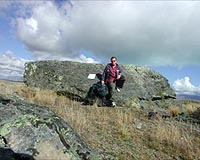| . |  |
. |
College Park MD (SPX) May 11, 2009 An international team of geologists may have uncovered the answer to an age-old question - an ice-age-old question, that is. It appears that Earth's earliest ice age may have been due to the rise of oxygen in Earth's atmosphere, which consumed atmospheric greenhouse gases and chilled the earth. Scientists from the University of Maryland, including post-doctoral fellows Boswell Wing and Sang-Tae Kim, graduate student Margaret Baker, and professors Alan J. Kaufman and James Farquhar, along with colleagues in Germany, South Africa, Canada and the United States, uncovered evidence that the oxygenation of Earth's atmosphere - generally known as the Great Oxygenation Event - coincided with the first widespread ice age on the planet. "We can now put our hands on the rock library that preserves evidence of irreversible atmospheric change," said Kaufman. "This singular event had a profound effect on the climate, and also on life." Using sulfur isotopes to determine the oxygen content of ~2.3 billion year-old rocks in the Transvaal Supergroup in South Africa, they found evidence of a sudden increase in atmospheric oxygen that broadly coincided with physical evidence of glacial debris, and geochemical evidence of a new world-order for the carbon cycle. "The sulfur isotope change we recorded coincided with the first known anomaly in the carbon cycle. This may have resulted from the diversification of photosynthetic life that produced the oxygen that changed the atmosphere," Kaufman said. Two and a half billion years ago, before the Earth's atmosphere contained appreciable oxygen, photosynthetic bacteria gave off oxygen that first likely oxygenated the surface of the ocean, and only later the atmosphere. The first formed oxygen reacted with iron in the oceans, creating iron oxides that settled to the ocean floor in sediments called banded iron-formations - layered deposits of red-brown rock that accumulated in ocean basins worldwide. Later, once the iron was used up, oxygen escaped from the oceans and started filling up the atmosphere. Once oxygen made it into the atmosphere, the scientists suggest that it reacted with methane, a powerful greenhouse gas, to form carbon dioxide, which is 62 times less effective at warming the surface of the planet. "With less warming potential, surface temperatures may have plummeted, resulting in globe-encompassing glaciers and sea ice" said Kaufman. In addition to its affect on climate, the rise in oxygen stimulated the rise in stratospheric ozone, our global sunscreen. This gas layer, which lies between 12 and 30 miles above the surface, decreased the amount of damaging ultraviolet sunrays reaching the oceans, allowing photosynthetic organisms that previously lived deeper down, to move up to the surface, and hence increase their output of oxygen, further building up stratospheric ozone. "New oxygen in the atmosphere would also have stimulated weathering processes, delivering more nutrients to the seas, and may have also pushed biological evolution towards eukaryotes, which require free oxygen for important biosynthetic pathways," said Kaufman. The result of the Great Oxidation Event, according to Kaufman and his colleagues, was a complete transformation of Earth's atmosphere, of its climate, and of the life that populated its surface. The study is published in the May issue of Geology. Share This Article With Planet Earth
Related Links University of Maryland It's A White Out at TerraDaily.com
 Southern Glaciers Grow Out Of Step With North
Southern Glaciers Grow Out Of Step With NorthNew York NY (SPX) May 04, 2009 The vast majority of the world's glaciers are retreating as the planet gets warmer. But a few, including ones south of the equator, in South America and New Zealand, are inching forward. A new study in the journal Science puts this enigma in perspective; for the last 7,000 years New Zealand's largest glaciers have often moved out of step with glaciers in the northern hemisphere, pointing ... read more |
|
| The content herein, unless otherwise known to be public domain, are Copyright 1995-2009 - SpaceDaily. AFP and UPI Wire Stories are copyright Agence France-Presse and United Press International. ESA Portal Reports are copyright European Space Agency. All NASA sourced material is public domain. Additional copyrights may apply in whole or part to other bona fide parties. Advertising does not imply endorsement,agreement or approval of any opinions, statements or information provided by SpaceDaily on any Web page published or hosted by SpaceDaily. Privacy Statement |